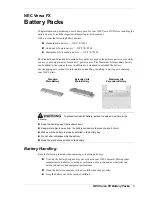
[
9
]
5 – Maintenance
The battery cabinet contains valve-regulated recombinant lead-acid (VRLA) batteries, which are maintenance-free relative to the
electrolyte. You cannot add water to these batteries or sample the electrolyte specific gravity. It is necessary, however, to periodically
check the charging voltage, temperature and connections of the individual battery units.
5-1 Maintenance Schedule
Quarterly Check
1.
Measure individual battery unit temperature. (Measure with a digital thermometer by placing the surface thermocouple on the
flat surface of the negative terminal—not the “L” connection surface. An infrared temperature monitor can also be used.
Temperatures below 77° F reduce battery performance and temperatures above 77° F reduce battery lifespan. Battery lifespan
is reduced by 50% for each 15° above 77° F. For example, battery lifespan will be reduced by half at 92° F.)
2.
Measure individual battery unit float charging voltages. (Measure voltage with a digital voltmeter. Measured voltage should
be between 13.2 VDC and 14.2 VDC. Battery units outside this range should be replaced.)
3.
Measure total battery cabinet float charging voltage.
Semiannual Check
1.
Repeat quarterly check.
2.
(Optional) Measure impedance or conductance of individual battery units.
3.
(Optional) Perform a high-rate, 100 A, 10 second performance capacity test of individual battery units. (The performance
capacity test is identical to the acceptance test in
Section 4-4
, and the same procedure should be followed.)
Annual Check
1.
Repeat semiannual check.
2.
Use insulated tools to tighten all connections to the recommended torque. (See
Section 7-2
for recommended torque values.)
3.
(Optional) Measure inter-battery connection resistance.
5-2 Fuse Replacement
Warning: Fuses should be replaced by qualified service personnel only. Blown fuses must be replaced with the same number
and type of fuses.
1.
The battery cabinet may contain a UL-listed, branch-rated fuse in the positive output (upper front of cabinet).
2.
Before attempting to replace the fuse, open the disconnect between the battery cabinet and the load/charger.
3.
Remove the front panel from the battery cabinet. Before attempting to replace the fuse, confirm that the battery is not shorted
to the cabinet. Use a digital voltmeter to measure the voltage between the cabinet and both sides of the fuse holder. This
voltage should measure 0 (zero) VDC. If the measured voltage is not zero, determine the cause and correct before
proceeding.
4.
Wearing rubber gloves and using insulated tools, remove any cables and/or terminal plates from the output side of the fuse
holder. Using the appropriate hex socket, remove the fuse from the holder.
5.
The replacement fuse must have the same voltage and current rating as the fuse being replaced (check the label on the fuse
being replaced).
6.
For nominal battery cabinet voltages less than or equal to 384 VDC, use fuses rated at 500 VDC. For nominal battery cabinet
voltages greater than 384 VDC, use fuses rated at 700 VDC.
7.
Install the replacement fuse and reconnect the output cables and/or terminal plates to the output side of the fuse holder.
8.
Reinstall the battery cabinet front panel and close the disconnect between the battery cabinet and the load/charger.


































